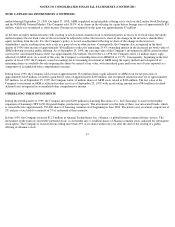Apple 1999 Annual Report Download - page 43
Download and view the complete annual report
Please find page 43 of the 1999 Apple annual report below. You can navigate through the pages in the report by either clicking on the pages listed below, or by using the keyword search tool below to find specific information within the annual report.NOTES TO CONSOLIDATED FINANCIAL STATEMENTS (CONTINUED)
NOTE 1--SUMMARY OF SIGNIFICANT ACCOUNTING POLICIES (CONTINUED)
Gains and losses on interest rate and foreign exchange instruments not accounted for as hedges are recorded in income as a component of
interest and other income (expense), net. Sold interest rate and foreign exchange instruments do not qualify as accounting hedges. Premiums
associated with sold foreign exchange option contracts are marked to market through earnings.
INVENTORIES
Inventories are stated at the lower of cost (first-in, first-out) or market. If the cost of the inventories exceeds their market value, provisions are
made currently for the difference between the cost and the market value.
PROPERTY, PLANT, AND EQUIPMENT
Property, plant, and equipment are stated at cost. Depreciation and amortization are computed by use of the declining balance and straight-line
methods over the estimated useful lives of the assets, which are 30 years for buildings, from 2 to 5 years for equipment, and the shorter of lease
terms or estimated useful lives for leasehold improvements.
LONG-LIVED ASSETS
The Company reviews property, plant, and equipment and certain identifiable intangibles for impairment whenever events or changes in
circumstances indicate the carrying amount of an asset may not be recoverable. Recoverability of these assets is measured by comparison of its
carrying amount, including the unamortized portion of any allocated goodwill, to future undiscounted cash flows the assets are expected to
generate. If property, plant, and equipment and certain identifiable intangibles are considered to be impaired, the impairment to be recognized
equals the amount by which the carrying value of the assets, including any allocated goodwill, exceeds its fair market value. The recoverability
of enterprise level goodwill is assessed whenever the facts and circumstances suggest the asset may be impaired. The Company assesses the
recoverability of enterprise level goodwill by determining whether the unamortized goodwill balance can be recovered through undiscounted
future cash flows. For the three years ended September 25, 1999, the Company has made no adjustments to its long-lived assets except those
made in connection with the restructuring actions described in Note 4.
STOCK-BASED COMPENSATION
The Company measures compensation expense for its employee stock-based compensation plans using the intrinsic value method and has
provided in Note 7 pro forma disclosures of the effect on net income (loss) and earnings (loss) per share as if the fair value-based method had
been applied in measuring compensation expense.
FOREIGN CURRENCY TRANSLATION
The Company translates the assets and liabilities of its foreign sales subsidiaries at year-end exchange rates. Gains and losses from these
translations are credited or charged to "accumulated translation adjustment" included in "accumulated other comprehensive income (loss)" in
shareholders' equity. The Company's foreign manufacturing subsidiaries and certain other entities use the U.S. dollar as the functional currency
and translate monetary assets and liabilities at year-end exchange rates, and inventories, property, and nonmonetary assets and liabilities at
historical rates. Gains and losses from these translations are included in the Company's results of operations and were not significant in 1999,
1998 or 1997.
39
























